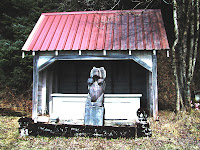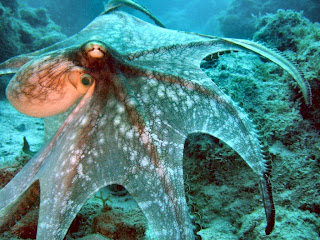Stone Angels

Inside the small cemetery, near the ferry terminal, centuries old spruce trees weep with sap and soggy green moss. The steep hillside behind is thick with Western Hemlock—yán, spruce and alder. A wire is strung between wood posts fencing off the cemetery. Long wispy strands of dried grass, like the unkempt hair on a newly awakened child, grow next to the fence.
 Stone bears
stand on hind legs guarding the old bones. White crosses and pink plastic roses
contrast with old marble headstones and Russian Orthodox crosses. Tree roots
protrude from underneath the remaining patches of snow like veins beneath a
layer of thin skin. Five stone angels, one headless, stand reverently in the
umbra above the wet sunken graves and matted grass. A green coverlet of emerald
colored moss creeps across the face of the headstones covering their ornate
details. I make out the names Williams, Jack, Marks; names carved in stone, clinging to eternity with the same names of those who still live in the
village.
Stone bears
stand on hind legs guarding the old bones. White crosses and pink plastic roses
contrast with old marble headstones and Russian Orthodox crosses. Tree roots
protrude from underneath the remaining patches of snow like veins beneath a
layer of thin skin. Five stone angels, one headless, stand reverently in the
umbra above the wet sunken graves and matted grass. A green coverlet of emerald
colored moss creeps across the face of the headstones covering their ornate
details. I make out the names Williams, Jack, Marks; names carved in stone, clinging to eternity with the same names of those who still live in the
village.  Hemlock branches
sag low across the cemetery forming a jade canopy. This type of hemlock can
grow from 100 to 150 feet and live to be 500-years-old. For at least a hundred
of those years, the spruce and hemlock have watched weeping humans tending to
grief, and reverent caretakers caring for the dead. It's hard to believe that in
the age of heavy machinery, villagers still dig the graves by hand. For them,
grave digging is part of the ceremonial aspect of death. Gravediggers are
helping with the grieving process and are remembered when our families hold the
memorial, the koo.éex.
Hemlock branches
sag low across the cemetery forming a jade canopy. This type of hemlock can
grow from 100 to 150 feet and live to be 500-years-old. For at least a hundred
of those years, the spruce and hemlock have watched weeping humans tending to
grief, and reverent caretakers caring for the dead. It's hard to believe that in
the age of heavy machinery, villagers still dig the graves by hand. For them,
grave digging is part of the ceremonial aspect of death. Gravediggers are
helping with the grieving process and are remembered when our families hold the
memorial, the koo.éex.  A pair of
eagles—ch'aak', sits on the pilings
at the ferry terminal dock, watching over the cemetery. Their black-feathered
bodies and white heads, a contrast to the bright fluorescent orange
weather-sock drooping down against the pole beside them. The eagles sit,
unmoving. Behind them, the morning sunlight pokes through the clouds; the light
dances on the water like a thousand shards of glass across a mirror.
A pair of
eagles—ch'aak', sits on the pilings
at the ferry terminal dock, watching over the cemetery. Their black-feathered
bodies and white heads, a contrast to the bright fluorescent orange
weather-sock drooping down against the pole beside them. The eagles sit,
unmoving. Behind them, the morning sunlight pokes through the clouds; the light
dances on the water like a thousand shards of glass across a mirror. * Stone Angels is excerpt from my creative nonfiction piece The Shape of a Village, which is published in Breadline Press' anthology Mad Road. (The village of Hoonah, Alaska)


Comments